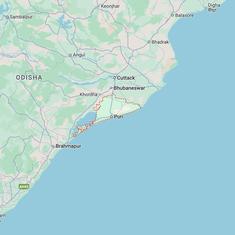Alarmed by the dwindling numbers of the Gangetic dolphin in the Ganga, scientists have identified stretches of the river for priority long-term conservation programmes to help revive the endangered species.
The Gangetic dolphin (Platanista gangetica), endemic to the Ganga river, plays a crucial role in stabilising the ecosystem, regulating the energy flow of the river and maintaining the fish and crustacean populations.
Listed as endangered by the International Union for Conservation of Nature, or IUCN, its population has dwindled in recent years, especially in the upstream stretches of the river, with estimates pegging the numbers between 2,500 and 5,000 individuals.
A new study has assessed the distribution, numbers and habitat suitability of the Gangetic dolphin in the small rivers of the Ganga basin and proposed a basin-wide river conservation strategy for the species.
Following the dolphin
During the post-monsoon seasons (November-February) in 2022 and 2023, scientists from the Wildlife Institute of India and the government agency National Mission for Clean Ganga surveyed the tributaries and sub-tributaries of the Ganga river, covering a total linear stretch of 1,290 km.
They observed that the Gangetic dolphin inhabited most tributaries and sub-tributaries of the river and plotted priority conservation stretches along the Ganga basin. “We have provided evidence of these smaller rivers being a refuge for aquatic macrofauna such as the Gangetic dolphin, and shown that the smaller rivers provide resilience to the larger rivers by contributing towards the functioning of ecological processes,” says Syed Ainul Hussain, a Wildlife Institute of India scientist and one of the authors of the study.
He adds that these lesser-known rivers harbour more than 15% of the Gangetic dolphins and contribute to habitat diversity. “This underscores the importance of conserving these rivers to safeguard biodiversity,” Hussain says.
The scientists have identified stretches totalling 620 km along the smaller rivers of the Ganga basin as conservation priority for systematic planning and involving various stakeholders.
The new study builds on the scientists’ 2022 recommendation to initiate basin-wide conservation initiatives. “These priority stretches will enable policymakers and managers to steer limited resources to achieve significant conservation goals in the future,” Hussain says.

Habitat mapping
The study has provided new data on the species’ habitat, such as the population status in some of the smaller rivers such as Rapti, Babai and Bagmati which were not reported earlier, says Ravindra Kumar Sinha, a retired professor of Zoology at the Patna University, who also helped develop India’s Conservation Action Plan for the Gangetic dolphin 2010-20.
“This is an important update on the population status of the Gangetic river dolphins in these lesser-known and hitherto barely-surveyed rivers,” adds Nachiket Kelkar, head of the Riverine Ecosystems and Livelihoods programme at the Wildlife Conservation Trust. “It can contribute to better understanding of dolphin trends across river networks, at the metapopulation level,” says Kelkar who is also member of the IUCN Cetacean Specialist Group that promotes conservation of aquatic mammals such as whales, dolphins and porpoises.
Based on their team’s population surveys, Kelkar and his colleagues have inferred that the Gangetic dolphin population is more or less stable in the Ganga river’s main channel but could be declining in tributaries such as the Gandak, Kosi and Mahananda. “We need more data using scientific survey methods such as double-observer surveys from across rivers,” says Kelkar. “At present, trends are difficult to track because different methods are being used in different rivers.”
The study also identifies environmental factors such as river channel geomorphology and human-induced stresses that affect dolphin presence, says Samir Sinha, joint director and chief ecologist at the Wildlife Trust of India in Noida. While these factors were previously known based on observational and natural history information, they were not validated through robust data and analysis, he says.
“The (new) study has successfully bridged this gap, providing valuable insights for dolphin conservation efforts,” says Sinha. Dolphin population surveys conducted in the rivers by the Wildlife Trust of India in recent years have shown fluctuations in dolphin numbers across different years. These fluctuations could be attributed to seasonal changes in river geomorphology and alterations in the anthropogenic disturbance regime, says Sinha.
Conservation challenges
The conservation of the Gangetic dolphin faces significant challenges. Experts point out that the construction of dams and barrages on the river have impacted the river flow and water availability, which is further compounded by the impacts of climate change. A proposed river-interlinking scheme has also drawn criticism for its potential impact on the species habitat.
Additionally, increasing pollution from agricultural run-offs that contain pesticides and other chemicals, directed and unintentional killings, increasing sediment deposition in the river due to loss of forests in their catchment areas, and the rise in mechanised boat traffic further, have also affected the species.
“There is a need for action from the local scale, such as managing fisheries better, to the river basin scale, such as dams and climate change impacts,” says Kelkar. “The challenges are large and cannot be wished away.”
Fortunately, there has been a rising awareness among people, as well as a conservation impetus by states and the central government, especially in the last 15 years, says Samir Sinha. “Intentional killing of dolphins has significantly decreased owing to increased awareness among fisherfolk and improved protection by enforcement agencies,” he observes.
Cooperative efforts
The primary measures to conserve the Gangetic dolphin include habitat protection and restoration, and mitigation of threats such as overfishing and net entanglement, says Hussain. Additionally, community engagement and awareness initiatives, research and monitoring efforts to track population trends and health, and collaboration with stakeholders such as government agencies, NGOs, and local communities are essential to ensure effective implementation and long-term sustainability of conservation efforts, he adds.
More funding could also lead to more surveys, and improved monitoring and science, experts say. “But for conservation to happen with positive results, people need to also invest effort on the ground with a lot of intent, and the timescale of change is slow,” says Kelkar.
He feels that influencing a behavioural change among river-dependent communities is a challenging task. With different kinds of conservation programmes, ranging from awareness to ground-level interventions, being implemented in different rivers and states, there needs to be more objective monitoring and evaluation to measure their impacts.
There are additional concerns that conservation programmes focusing largely on awareness and outreach could end up with plenty of platitudes but no tangible benefits to the fishing communities, who are among the most vulnerable but most important stakeholders in river conservation, points out Kelkar.
He suggests that in addition to building social trust and equity, conservation programs should include robust scientific monitoring of dolphin populations, hydrology, threats, and the impacts of different interventions; engaging with river water use and management policy, such as how to re-operate dams to provide more water for rivers, mitigation measures for existing infrastructure development projects, or avoiding projects that will cause irreversible damage.
According to Samir Sinha, conservation action plans must be tailored to each site, encompassing enforcement measures, habitat protection by increasing the number of protected areas for dolphins, maintaining ecological flow in rivers, technological interventions to reduce accidental deaths of dolphins, addressing community concerns, and implementing innovative approaches of stakeholder engagement. Population monitoring is essential to gauge the efficacy of conservation measures.
Finally, the survival of dolphins critically depends on the health of rivers, he points out. Water development projects fragment dolphin habitats, jeopardising their long-term survival. He says, “It is imperative to reintroduce dolphins into suitable stretches of rivers where they have become locally extinct, thereby replenishing their populations and ensuring their continued existence.”
This article was first published on Mongabay.










